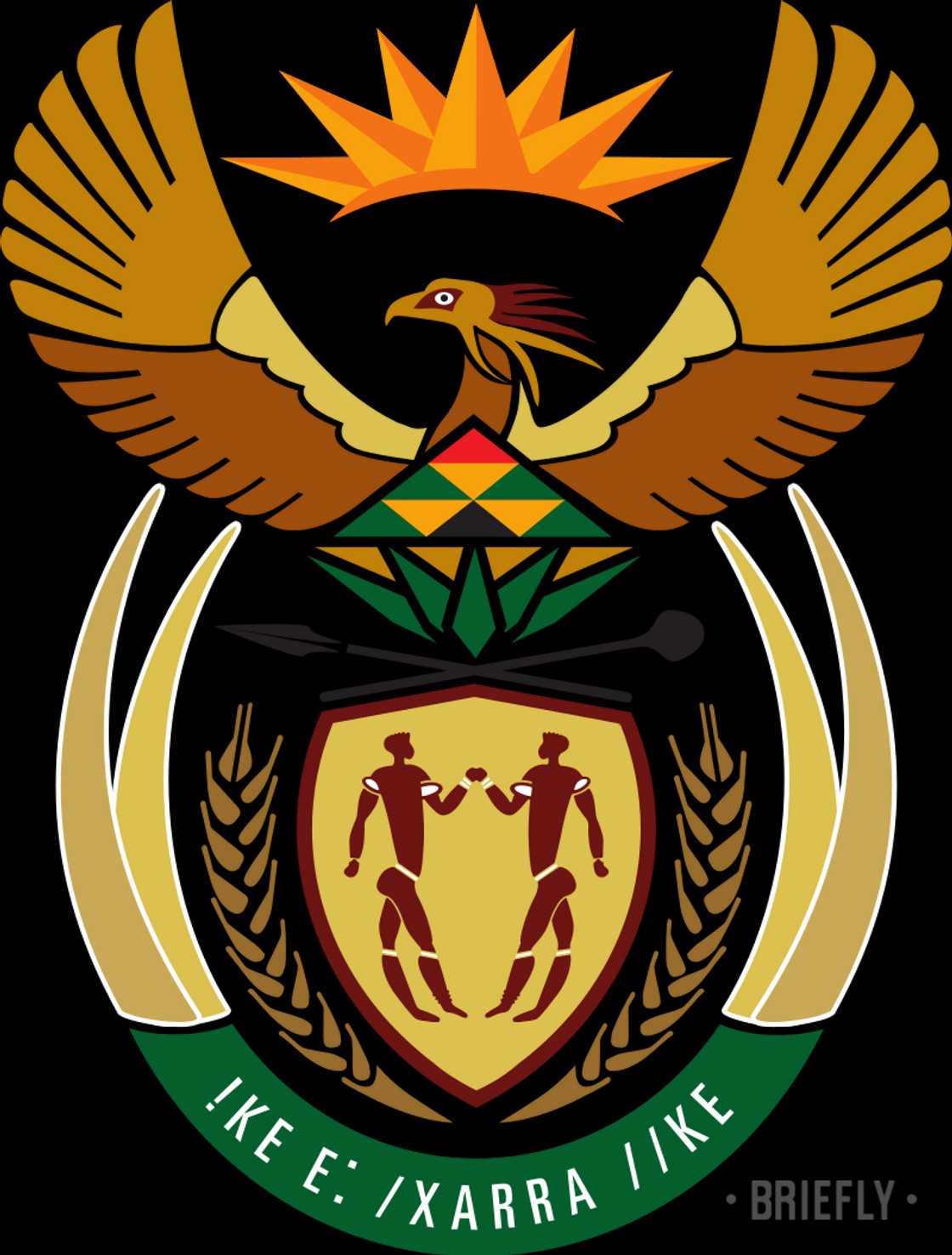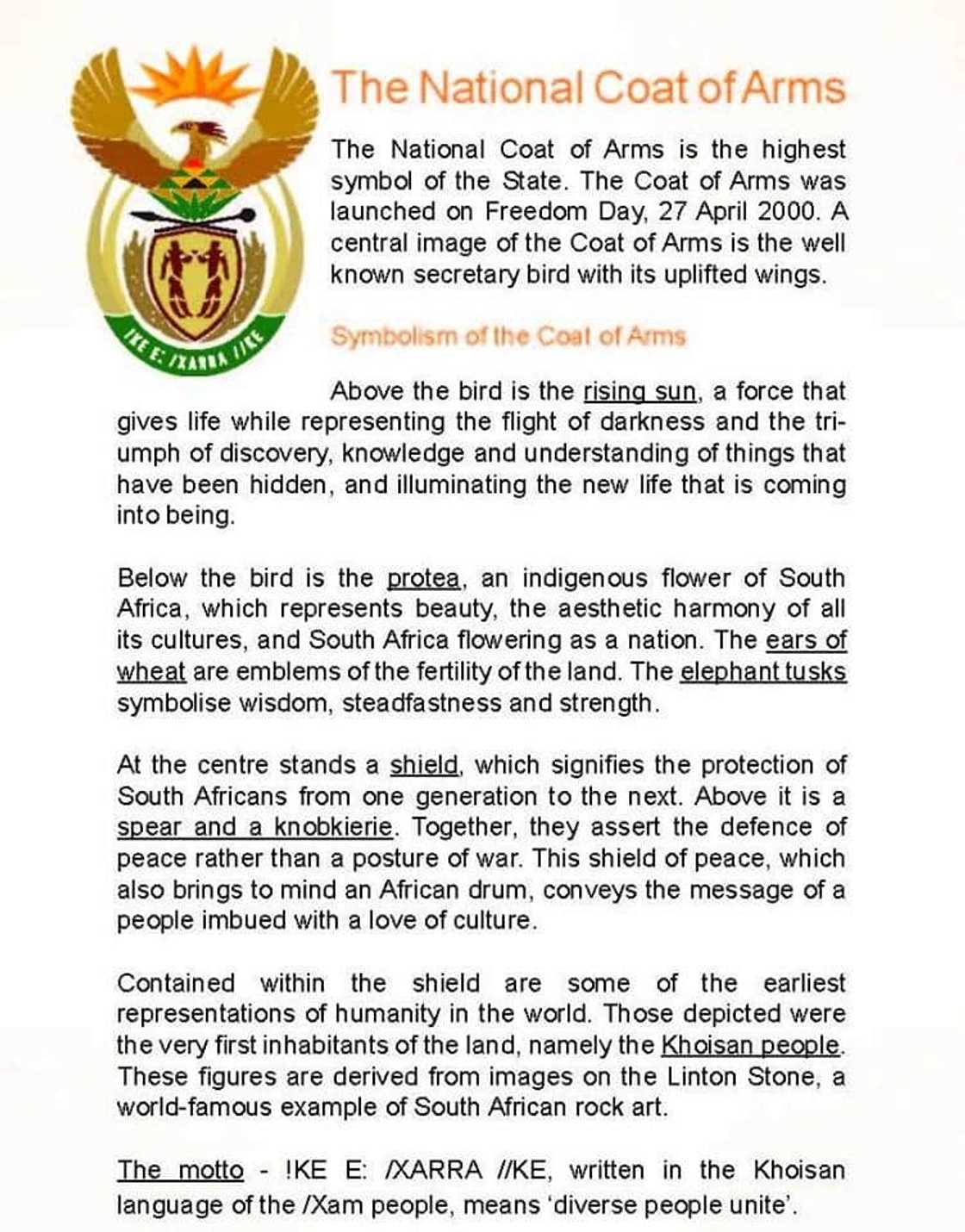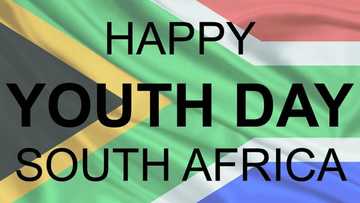South African coat of arms explained in simple terms
Every country has a symbol that unites its citizens, regardless of their background or social differences. The emblem also plays a significant role in providing citizens with a sense of belonging. The South African coat of arms is an example of a symbol of national unity. Each of the symbols in the coat of arms, however small, has a significance. It is therefore vital to be informed on what each of those symbols means and what your role is as a citizen towards ensuring that you fulfill your responsibility.

Source: Original
The South African coat of arms is the most common symbol of national unity. The National Coat of Arms is found in relevant documents like the birth certificates and passports. The logo of the South African coat of arms in each of these documents is a symbol of national unity. It also gives the citizens of South Africa a sense of belonging and symbolizes the new system of governance and the citizens’ obligation to be patriotic. Explained below are the symbols of the National Coat of Arms and their significance.
What are the national symbols of South Africa?
Most countries have symbols that symbolise national unity. These symbols are found in most of the documents and currency. The essence of these symbols is that they emphasise on the value of the citizens to the country. They also make the citizens valued. For instance, these are the national symbols of South Africa.
- The National Coat of Arms
- The National anthem
- The National flag
- The National fish
- The National bird
- The National tree
- The National flower
- The National animal
READ ALSO: 5 South African National Symbols and what they mean
What does the coat of arms symbolize?

Source: UGC
The coat of arms South Africa is the most common symbol of national unity. The South African is found in nearly all the essential documents. These documents include birth certificates, marriage certificates, school certificates, death certificates, and passports. It is also found in South African currency, even in the coin with the least value. It also emphasizes the sense of belonging for the citizens in the country.
What is the role of the National Coat of Arms?
The National Coat of Arms of South Africa was launched on the 27th of April, 2000. The launch signified a change in the government. The difference in the government was manifested in the democratic form of leadership. It also brought forth a new type of patriotism. The South African National Coat of Arms, therefore, plays a significant role, since it symbolizes the original form of governance. It is also the most common symbol of national unity. This is so because it is found in most of the federal documents. That means that the government has approved it.
South African coat of arms symbols and meaning
The motto
The motto of the coat of arms is South African ‘!ke e: /xarra //ke’. It is in the Xhoisan language of the /Xam subgroup. Those words mean; ‘diverse people unite.' The motto emphasizes the efforts that every individual has to put in to ensure that there is unity in their actions and thoughts. It promotes the spirit of unity in the nation, which will influence a sense of belonging hence the spirit of national pride.
The shield
The shield signifies the spiritual defense for the country. It also acts as a vessel for the display of identity.
Elephant Tusks
The elephants in the South African coat of arms are also symbolic. They signify eternity, strength, wisdom and moderation.
The ears of wheat
The ears of wheat are a symbol to emphasize the country's fertility. They also represent germination, growth, and all the forms of development, which also appreciates the people of South Africa. The ears of wheat are also a representation of the country's vibrant agricultural sector.
The spear and knobkierie
The spear and knobkierie have two significant meanings. They are a symbol of authority and defense. They also represent the strong legs of the secretary bird. The image of the spear and knobkierie placed down signifies peace.
The secretary bird
The secretary bird is an emblem of war and the natural effects of development and speed. The secretary bird on the South African coat of arms can be likened to a lion on earth. The spear and knobkierie symbolize the strong legs of the bird. The bird’s normal nature of hunting for snakes is significant too. It brings out the aspect of protecting the country from its adversaries. Since the secretary bird flies, it also symbolizes a messenger that carries divine majesty. The bird’s lifted wings represent the nation’s potential for growth. It also signifies the bird offering protection to the country. The color of the bird in the coat of arms is gold, which signifies the country’s high power and its relation to the sun.
The human figures
The human figures in the South African coat of arms have been obtained from the images on one of South Africa’s Rock Art, the Linton stone. These South African Rock Art are now available in the South African Museum, which is located in Cape Town. The human figures in rock art are portrayed in the form of greetings, which symbolize unity. They also represent the growth of the sense of belonging in the country and collective humanity.
The Protea
The protea is a sign of the beauty of South Africa and the blossoming capability of South Africa to attain African Renaissance. The protea images are normally seen below the secretary bird. Protea pictures represent flowers which are also a symbol of national unity.
The rising sun
The rising sun symbolizes the brightness, the magnificence, and the principle of the beauty of nature. The light signifies the promise of good reflection, rebirth, willpower, sound judgment, and knowledge. It also symbolizes the wholeness of humanity and the source of light and life.
South Africa is one of the countries which attained independence a few years ago. Its change in the system of governance is a part of the advantages that came with freedom. The South African coat of arms is a symbol of this. It is, therefore, the responsibility of both the citizens and the government to ensure that the significance of the coat of arms is upheld. For a smooth and peaceful co-existence of both the citizens and the leaders, the symbols of the South African coat of arms should be understood to the latter.
READ ALSO:
- South Africa 2010: What is the lasting legacy of Africa’s World Cup?
- What's the big idea behind Reconciliation Day?
- Now is the time for each of us to say ‘send me’: President Cyril Ramaphosa's SONA2018 promises
Source: Briefly News






